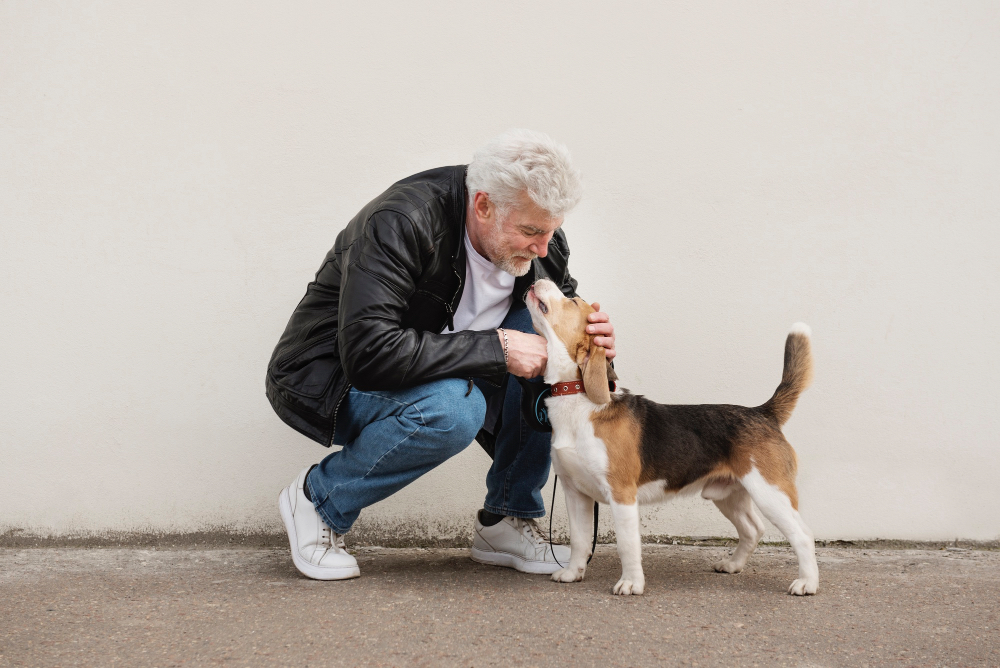01. When Is Your Dog Considered Senior?
Not all dogs go gray at the same rate. Your Great Dane might be considered a senior at 6, while your Chihuahua is still living their best adult life. Understanding when your dog enters their senior years helps you make timely dietary adjustments [1].
Age Guidelines by Size
- Small Dogs (under 20 lbs): Senior at 10-12 years
- Medium Dogs (20-50 lbs): Senior at 8-10 years
- Large Dogs (50-90 lbs): Senior at 7-9 years
- Giant Dogs (90+ lbs): Senior at 6-8 years
02. Essential Nutrients for Aging Dogs
Your senior dog’s body needs specific nutrients to stay healthy and active. Here’s what should be in their food bowl [2]:
Key Nutrients for Senior Dogs
- High-Quality Protein: Maintains muscle mass and supports immune function
- Look for 25-30% protein content
- Choose easily digestible sources like chicken, turkey, or fish
- Joint Support Nutrients: Helps maintain mobility
- Glucosamine
- Chondroitin
- MSM
- Omega-3 fatty acids
- Antioxidants: Supports cognitive function and immune health
- Vitamin E
- Vitamin C
- Beta-carotene
03. Common Health Issues and Diet Solutions
Senior dogs often face specific health challenges that the right diet can help manage [3]:
Dietary Solutions for Common Senior Issues
- Joint Problems:
- Foods rich in glucosamine and chondroitin
- Omega-3 fatty acids for inflammation
- Easy-to-maintain healthy weight
- Digestive Issues:
- Highly digestible proteins
- Added probiotics and prebiotics
- Limited ingredient diets if needed
- Dental Problems:
- Appropriate kibble size and texture
- Dental-supporting ingredients
- Soft food options if needed
04. Choosing the Right Senior Dog Food
Selecting the perfect food for your senior dog involves understanding labels and knowing what to look for [2].
Reading Labels Like a Pro
- Guaranteed Analysis:
- Protein: Aim for 25-30%
- Fat: Look for 10-12%
- Fiber: 3-5% is ideal
- Moisture: Varies by food type
- Ingredient Red Flags:
- Generic meat by-products
- Artificial preservatives
- Excessive fillers
- Artificial colors
- Quality Indicators:
- Named meat sources first
- Natural preservatives
- Added vitamins and minerals
- Specified protein meals
Save time comparing different brands and formulas - use our pet food finder to quickly filter senior dog foods based on your specific requirements.
05. Managing Weight in Senior Dogs
Weight management becomes crucial in the senior years, as excess pounds can stress aging joints and organs [4].
Weight Management Strategies
- Calorie Control:
- Adjust portions based on activity level
- Account for treats in daily calories
- Use measuring cups, not eyeballing
- Monitoring Tips:
- Weekly weigh-ins
- Regular body condition scoring
- Tracking energy levels
- Exercise Balance:
- Gentle, regular activity
- Adjusted for mobility issues
- Combined with appropriate diet
06. Food Sensitivities in Older Dogs
As dogs age, they may develop new food sensitivities or intolerances. Understanding and addressing these changes is crucial for their comfort and health [3]. Ready to find senior dog food that works with your pet's sensitivities? Try our pet food finder tool to discover options tailored to your senior dog's needs.
Managing Food Sensitivities
- Common Signs of Food Sensitivity:
- Digestive upset
- Skin irritation
- Excessive itching
- Ear infections
- Common Trigger Ingredients:
- Chicken and beef proteins
- Wheat and corn
- Dairy products
- Artificial preservatives
- Finding Solutions:
- Limited ingredient diets
- Novel protein sources
- Grain-free options if needed
- Elimination diet trials
07. Creating a Senior Dog Feeding Schedule
A consistent feeding schedule helps maintain energy levels and digestion for senior dogs.
Optimal Feeding Practices
- Meal Timing:
- 2-3 smaller meals daily
- Consistent feeding times
- Last meal 2-3 hours before bedtime
- Special Considerations:
- Medication timing with meals
- Water availability
- Treat limitations
- Monitoring Tips:
- Track eating habits
- Note any changes in appetite
- Watch for difficulty eating
08. Your Senior Dog Food Questions Answered
Common Questions and Expert Answers
- Q: How do I know if my senior dog's food is working?
A: Monitor their energy levels, coat condition, weight, and stool consistency. Look for bright eyes, good mobility, and maintenance of muscle mass. - Q: Should I still feed twice a day?
A: Yes, most senior dogs do best with 2-3 smaller meals daily rather than one large meal. This helps maintain stable blood sugar and energy levels. - Q: What if my senior dog won't eat their food?
A: First, rule out medical issues with your vet. Try warming the food slightly, adding low-sodium broth, or mixing in small amounts of wet food to increase palatability. - Q: When should I switch to soft food?
A: Consider switching to soft food if your dog shows signs of dental problems, decreased appetite, or difficulty chewing. Always consult your vet first.
Key Takeaways
- Senior dogs need specific nutrient profiles based on their size and age.
- High-quality protein is crucial for maintaining muscle mass.
- Joint support ingredients become essential in senior dog food.
- Weight management is critical for senior dog health.
- Food sensitivities may develop with age.
- Regular vet check-ups help monitor nutritional needs.
- Proper hydration becomes increasingly important with age.
- Transitioning to senior food should be done gradually.

